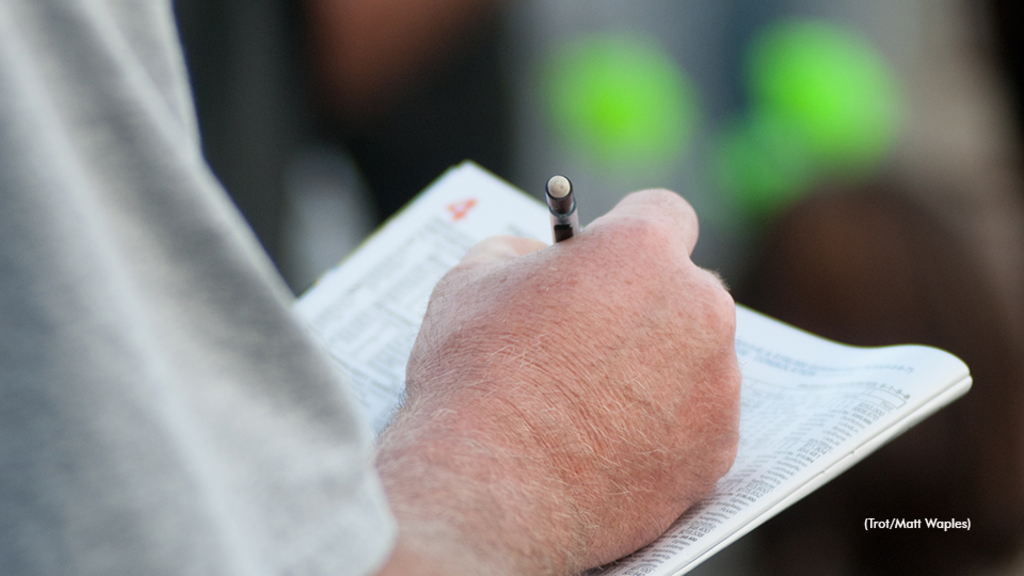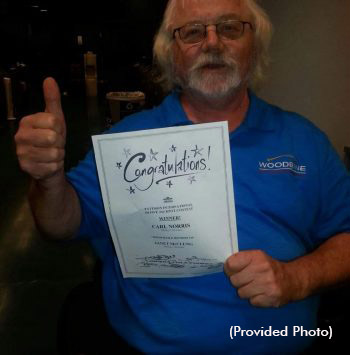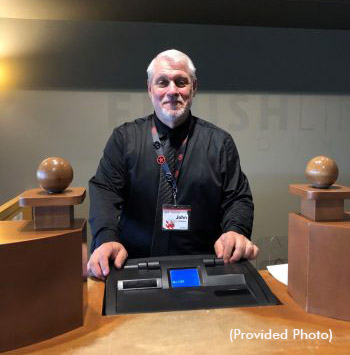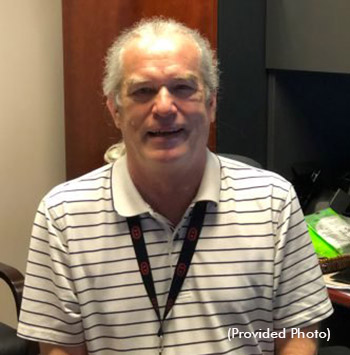
"You’re not just a mutuel clerk if you’re in the industry. If you really like the horses, you get involved, either owning or getting a job in the backstretch, or clocking horses. It’s intertwined with mutuels. We just don’t sell tickets. A lot of us just didn’t sell tickets. We trained horses and had all those other jobs connected with the industry.”
A candid statement from none other than Carl Norris. An entry clerk, a mutuel teller, a Standardbred owner and trainer, Norris has spent 52 years working in the industry in various career paths.

Yes, you may have been a punter (bettor) at his window, either at Woodbine, Mohawk Park, Fort Erie, Garden City in St. Catharines, or even the Deerfield teletheatre in Oakville. It’s safe to say, Norris is well-travelled when it comes to the province’s Thoroughbred and Standardbred racing circuit. He admits it too.
“I drove back and forth for 50 years – I’ve probably got a couple million miles over my career.”
Norris began his career at Fort Erie back in the 70s, while trainer Julia Carey found herself working as a mutuel teller at Greenwood some 30-odd years ago.
“I loved the job because I enjoy horse racing, and I got paid to watch races.”
A well-known trainer at Woodbine, Carey reminisces about those early days working as a teller. “That was in the days when there was only Woodbine. We didn’t have simulcasting or anything. Big crowds, lots of fun. I thought it was the greatest job in the world.”
Asked about any customers that stood out, Carey is quick to respond.
“They were all characters. They would bid on two flies running up the wall. We had a good time, though.”
While Norris and Carey moved on to other jobs in the industry, working as a mutuel teller provides a window into the world of racing that you might not otherwise see. Most importantly though, a teller provides a friendly face to customers visiting the track.
One such face is John Bradshaw.
Bradshaw has worked in the industry for more than 35 years, starting in the money room at Greenwood before becoming a mutuel teller. No doubt, he’s seen a fair share of customers over the years, both the seasoned bettors as well as newcomers to the game.
“In general, you get a mixture of both. On the bigger days, you’ll have a lot of new people who’ve never bet before. It’s a learning curve for themselves and they have to learn how to bet – but it’s not hard to do at all."

While it’s not hard to place a bet, it still can be intimidating. But as Bradshaw advises, you don’t need to spend big to enjoy the races.
“For a layman, if they want to come to the racetrack and spend $20 for the day, they can and have a good time without spending a lot of money. So, they could do just a two-dollar bet per race and it gives them a chance to cheer for something and, who knows, they could pick a winner and go home with some extra money.”
Deducing how to pick your horse or horses for a bet is a whole other story in itself. Generally speaking, the professional handicappers will dissect the racing form, analyzing each horse’s PPs (past performances) and recent works to determine the horse’s possible chances of winning the specific race they’re entered in. Bettors can rely on the handicapper’s picks or handicap the race as they see fit. As Bradshaw has found, people like to handicap in various ways.
“People will handicap the jockeys, they will handicap the trainers, some like certain owners. So, there’s all those things. What track they are running on, if they are running on the tapeta or if they are running on the turf track – all those factor into how they bet for a seasoned bettor. For a newbie, sometimes it’s what the horse looks like, if it’s a grey horse, if it’s all black or what the colour of the jockey’s silks are, and that’s fine too because they are here to have a good time.”
Suffice to say, various elements are considered before numbers are crunched and bets are placed. Spending more than three decades in the sport, Bradshaw has placed too many bets to remember.
However, one bet has remained at the forefront of his memory.
“The best time I had so far was about three or four years back, there were three ladies who came to Woodbine for Mother’s Day in the dining room. So, three generations – a daughter, mother and a grandmother. It was just the ladies, no husbands, no boyfriends. We have a Hi-5 in the last race, where you have to pick the top five finishers. It’s a risky race, but sometimes the carryover pools are quite large and they took a big risk and boxed every horse, which could hurt them in the end because they could hardly win anything, but for them, it was lucky. There were a couple of longshots that day that came in and they won the whole pool. They walked away with over $50,000. That was their first time at the racetrack, too, so they were ecstatic.”
That day, Bradshaw said they spent about $3,500 on their Hi-5 ticket. But with a return of more than $50,000, it most certainly paid off.
“I cashed them out. I said, ‘I can get you security if you want, or the best thing to do is each person put a bunch of money in your purse and walk out calmly to your car.’ They did that. I said, ‘As soon as you get home, throw it up in the air and jump underneath it.’”
A simple transaction that can leave your pockets full and leave your heart even fuller in a rare instance. Just ask Sheila Galloro, Woodbine’s Senior Manager of Cash Operations, who met her husband while she was a casual mutual teller back in the 90s.
“Well, he would come on the weekends and wager with me. At the end of one season, when we were closing Woodbine and moving to Greenwood, I said, ‘Well, it’s been nice seeing you through the season – see you next year.’ He said, 'Are you going somewhere?’ I said, 'We are moving down to Greenwood now for that meet.' I knew he lived in area. So anyways, opening night at Greenwood, I was serving customers, head down, selling tickets, and I looked up, and there he was standing at my window, and he placed a wager. When he left, the girl beside me said, ‘Oh, that guy, his eyes just light up when he gets to your window.’ I started laughing.”
Five years later, they were married.
After working as a mutuel teller for eight years, Galloro moved to the scheduling department for mutuels then became a mutuel manager at Woodbine and Woodbine Mohawk Park. In 2014, Gallaro transitioned into her current role in cash operations at the Rexdale oval. However, it should be noted that her initial start at the track was back in the early 70s. Hold your horses because this quick trip down Galloro’s memory lane is one that many would have liked to witness firsthand rather than read about decades later.
“When I was in high school, back in 1972-1973, I was actually working the day that Secretariat raced here, which was phenomenal. It was an amazing experience. It was very busy and I had a special assignment that day. I was operating one of the elevators and I was fortunate enough to take the owners up to their dining rooms. It was very busy, very crowded and, of course, just before the race, the skies got so dark and just a downpour of rain. It didn’t matter; the whole building emptied out onto the apron. It was amazing.”
A precious moment in time, and with a love of the industry developed early on, Galloro found herself back at the track in the early 90s. She remembers those days all too well.
“I came back in 1992. I started as a causal teller. Back then there was only wagering on the one track, which was Woodbine. So, we were very busy. There were no OTBs, this was the only location you could wager. As the years progressed, when the horses moved to Greenwood, you could wager here, like simulcasting, and then we took on the simulcasting of other tracks and then the OTBs opened and then attendance declined because people found it convenient to stay in the neighbourhood and wager,” said Galloro, who also worked as a teller in the OTB network.
Galloro notes that tellers would also travel from track to track such as Greenwood and Fort Erie. As the years went by, simulcasting of other tracks was picked up.
“They used to have tellers only selling specific tracks. You only sold Fort Erie, or you sold Woodbine, or Santa Anita and then they amalgamated all that and you could sell all the tracks. So that was very different for some of the original tellers, because at one time, you wagered with a mutuel employee, or you cashed with a mutuel employee – they didn’t do both. Over the years, there has been many changes.”
While times have changed and betting on races is more accessible to fans via online platforms such as HPIbet and apps such as Darkhorse, there is something to be said for that human interaction.
“It was enjoyable to see new guests because they were just so thrilled to have someone explain to them how it all worked and especially if they won,” said Galloro.
Winning a few dollars is one thing, but winning a sizeable jackpot is another. So, while certain bettors may jump for joy and run to cash out their bets, some might react differently. Norris knows this sentiment to be true.
“At Fort Erie years ago, I remember a lady won quite a bit of money and she was scared. I said, ‘Hey, I’m off work in a while, I will take you to your car. And you could just see her relax because she was worried that somebody might be following because they saw the payout,” said Norris, who worked at the border oval during that time in the 80s.
Although this was not part of his job description, Norris felt inclined to help the lady out and ensure she made it safely to her car.
“The races were over and I was off duty. I was going home anyhow and I told her it was no trouble. But now, if that ever happened, I would ask the customer, 'Are you alright with this kind of money? If you’re not, I’ll call security and security would lead you to your car.’”
Exciting as it may be to score big, the customer must also feel safe. Norris was no stranger to the principle during his tenure as a teller.
“I always wanted it to be a safe experience for the customers,” said Norris.
While safety is a paramount feature in the wagering game, so too is accessibility. Mike Klamot, the mutuel supervisor at Woodbine, keenly understands the need for betting to be accessible and not limited to just one format.
“When you walk in the door, you will have a teller, you will have a self-serve machine. Also, in the dining room, you have both a teller and self-serve machine," said Klamot. "We also have an ambassador and they have tablets, so while you’re having your dinner, you don’t want to get up and they will come to you with a tablet, explain what experiences are available for the day and they will take your bets off the tablet. They will print the ticket right there for you. Once the race is gone and if it’s a winner, that ambassador will come right up to you and cash it right there. Also, for people who have medical conditions, I find this works absolutely beautiful and they are so happy with that. And we do have handicap machines all across the building."

Catering to the needs of racing fans, Klamot understands that certain customers enjoy a more discreet type of betting.
“We have customers that want to be by themselves, they have an HPI account and we have a carol here where you can sit and bring your computer. If you have an HPI account, you can do all your betting on there.”
As Norris mentioned, working as a mutuel teller doesn’t mean you will always be a teller.
This was the case with Klamot, whose venture into the world of horse racing began as a teller at Greenwood. He’s also worked for tote and as a manager at Champions before eventually transitioning to his current role as mutuel supervisor.
“In different ways, I’ve been coming through those doors for over 30 years, and it’s been a love affair.”
A passion for the game and for the company, Klamot is more than happy to explain to customers the different types of wagers and get them more acquainted with the betting aspect of the sport. He also offers up some interesting tips in lieu of what the handicappers might advise.
“Just pick numbers, part of your street number, part of your phone number, part of a number that means something dear to you. Just try that formula for a little bit – I’m not saying you’re going to win all the time, but you’ll have a better chance of getting a higher price.”
Klamot continues to explain the betting scene at the Rexdale oval as a sea of racing fans, both seasoned gamblers and newcomers watch the live racing broadcast across the TVs on the second floor of Woodbine’s grandstand. The atmosphere is dictated by gasps, sighs and encouraging words ushered by the bettors as they watch their horse dash across the wire first or conversely watch a longshot sneak up the rail and beat what they thought was a sure bet.
The crumple of losing bets, dashed hopes, meets the scurry of fast feet heading to the counter to cash in those elusive winning tickets. Tellers continue to cash and place bets as the lines trickle in and out from race to race.
From the outset, it’s a simple transaction, but just remember that behind every bet and each teller, there’s a story waiting to be told.
(Woodbine)

